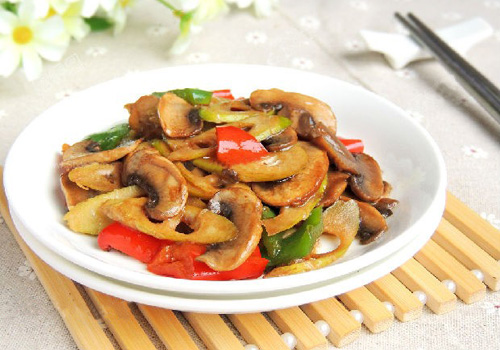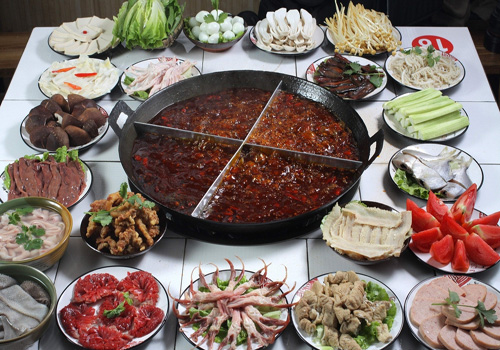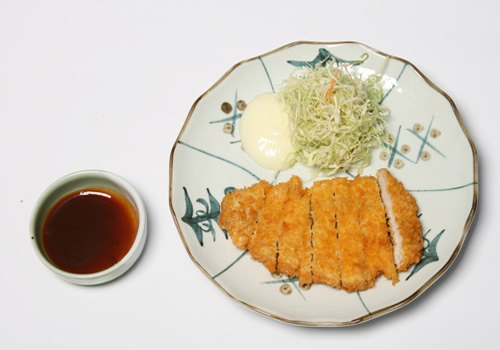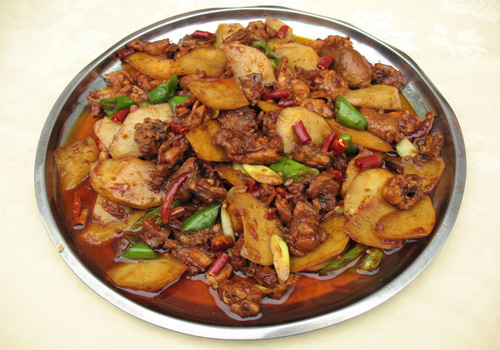A Bite of China II - Encounters, food materials combinations create brilliant flavors
2014-05-28China travel Guide
Most dishes are fissile wonders produced by kinds of food materials' combination and encounters. Human activities facilitate food's meeting, while the separation and reunion of food mobilize human’s meeting and parting. This is summarized to "destiny" by people.
Xilingol of Inner Mongolia, fertile soil provides flocks and herds with nourishment, and people with a valuable and rare mushroom, calocybe gambosa, a material to make a local specialty Stewed Chick with Mushroom. However, this mushroom rises to fame in Zhangjiakou City owing to a famous dish Stewed Mushrooms with Winter Bamboo Shoots, known as Braised North and South among Chinese, as mushroom from north China and the later is from regions south of Yangtze River 2000 kilometers away. Dried white mushroom, the top grade of calocybe gambosa, bloated in boiled water, then is whipped repeatedly in clear water in order to remove all sands; slice the mushroom and bloated dried bamboo shoots, stew them together in soup-stock, then stir-fry with oil on slow fire, and last add in the water for bloating mushroom, the famous delicacy is done.

Stewed mushrooms with winter bamboo shoots, Zhangjiakou
Daliang Mountains of Sichuan, germinates the symbolic spice in Southwest China, wild pepper, which produces a prickly taste. Dalou Mountains of Chongqing, Tujia people plant the best pod pepper. When these two materials meet in Chongqing, here comes the famous Chongqing hot pot condiment. To make the condiment, kinds of peppers are stir-fried and stewed with beef tallow, bean paste, fermented soya beans and bruised ginger. Apart from aroma condiment, the mouthwatering flavor of Chongqing hot pot attributes to its unique hot food, special processed pig trachea and cattle stomach, duck intestines, gizzard, corydoras and any food materials in common families. Hotpot is the symbol of Chongqing, and develops uniquely in different places, Beijing instant-boiled sliced mutton hot pot, Yunnan mushroom hot pot, Chaoshan beef hot pot, and the like.

Chongqing hot pot
Human’s migration brings more variate of food. Shenzhen, the youngest city in China crowded with new migrants and their hometown food, egg puff, tapioca pearls, toasted sausage, portuguese-style baked scallops, steamed mandarin fish with tofu, stewed mandarin fish in pumpkin soup, poached seafood...but the city also has its own aboriginal people and food. Villagers in Xiasha Village hold a banquet with their ancestor-worshipping celebration. The banquet is a basin meal only serve one dish but a dish includes all. They divide the work; a dozen of materials, mushroom, fungus, sleeve-fish, eel, radish, oyster... are washed, chipped, and cooked separately in the meantime. After, light radish are paved in the bottom of a basin, then cover with kinds of thick taste seafood and meat layer by layer; flavors are inter-infiltrated in the basin. Though only one dish for the banquet, Basin dish is the reunion of both food and people.

Basin meal, Shenzhen
The capital moving from Kaifeng to Hangzhou in Song Dynasty in 1127 A.D. Brought about some similar dishes in these two cities. West Lake fish in sweet and sour sauce is now a famous dish in Hangzhou cooked with grass carp, while the same dish is cooked slight differently in Kaifeng with carp. Kaifeng’s soup buns has been reformed to be fresher in the taste, while Hangzhou still make steamed buns in ancient Kaifeng’ technology. Yet Hangzhou has its indigenous delicacy, Noodles with preserved vegetable. Seasonal Bamboo shoots and potherb mustard are the main ingredients.

Noodles with preserved vegetable, Hangzhou
170 years ago, when Shanghai port opened up, western food invaded this city and symbolized elegant for a time, but smart Shanghai people used their own way to make western dishes with Shanghai flavor. Fried pork chop is a representation. Flap the pork repeatedly to make it floppy, then soak it in egg mixture and coat it in flour, repeated these two processes for three times, lastly coat with breadcrumbs and fry it. Pungent sauce is the match for Shanghai fried pork chop.

Fried pork chop, Shanghai
Xinjiang, the westmost in China, has a time-honored spread history of food because of the ancient Silk Road. Food materials and spices get together here and offers fine conditions for making delicacies. Stewed mutton with noodles, a familiar Xinjiang dish to people, is considered the best if with scattered onion, while Saute spicy chicken with potatoes is a remarkable food combinate in Xinjiang. Fry sugars till they turn into brown, add in chicken, Sichuan cuisine’s symbol pepper, Gansu people’s favorite potatoes successively, stew all the material after fry; last add in Shanxi’s “belts” noodles before serving on table.

Saute spicy chicken with potatoes, Xinjiang
The orient and the occident, south China and north China, humans’ migration facilitate food encounters, and the food separation and reunion witness that of people. However, whether people change the food, or food changes people, the dishes on tables and the flavors on tongue tips will tell the truth.
--- By April (VisitOurChina)
Preview:A Bite of China II - Daily Domestics, common but unforgettable home-cooked foods
Next:A Bite of China II - Realm of Secrets, the “hidden” delicacies in China




